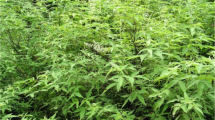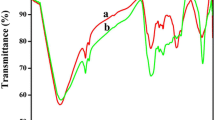Abstract
The defluoridation of ground water is regarded as one of the key areas of attention among the universal water community. The present investigation deals with fluoride removal from aqueous solution by thermally activated biosorbents prepared from banana (Musa paradisiaca) peel and coffee (Coffea arabica) husk. Fluoride ion selective electrode was used for the determination and monitoring of fluoride ion concentration. Batch experiments were conducted to establish the optimal conditions like pH, dose of the adsorbent, and contact time. The optimum pH was found to be 2 for both the adsorbents, and the optimum dose was found to be 24 g/250 mL at 13 h contact time for banana peel and 18 g/250 mL at 3 h contact time for coffee husk. The concentrations determined in real water samples of flour factory, poultry, and Lake Hawassa sites were 12.54, 11.02, and 6.72 mg/L, respectively. The prepared biosorbents were applied on these water samples under optimized conditions and found to be effective with removal efficiency ranging from 80 to 84 %. In terms of time and adsorbent dose required, coffee husk was observed to be much better than banana peel. The adsorption process obeyed Langmuir adsorption model. From the kinetic perspective, the fluoride adsorption followed the pseudo second-order reaction kinetics.






Similar content being viewed by others
References
Abdullah MA, Prasad AGD (2009) Kinetic and equilibrium studies for the biosorption of Cr(VI) from aqueous solutions by potato peel waste. Int J Chem Eng Res 1(2):51–62
Abebe W (2010) Health hazards of fluoride as related to Ethiopia: a review of some relevant issues for preventive approaches. Ethiop E-J Res Innov Foresight 2(1):59–84
Adeno F (2010) Adsorptive removal of fluoride from water using nano scale aluminium oxide hydroxide. M. Sc. Thesis. Addis Ababa University, Ethiopia
Agarwal M, Rai K, Shrivastav R, Dass S (2003) Defluoridation of water using amended clay. J Clean Prod 11:439–444
Alagumuthu G, Veeraputhiran V, Venkataraman R (2010) Adsorption isotherms on fluoride removal: batch techniques. Arch Appl Sci Res 2(4):170–185
Alagumuthu G, Veeraputhiran V, Venkataraman R (2011) Fluoride sorption using Cynodon dactylon-based activated carbon. Hem Ind 65(1):23–35
Alemu S (2009) Investigation of fluoride adsorption on manganese oxide modified aluminium oxide hydroxide. M. Sc. Thesis, Addis Ababa University, Ethiopia
Aliabadi M, Khazaei I, Fakhraee H, Mousavian MTH (2012) Hexavalent chromium removal from aqueous solutions by using low-cost biological wastes: equilibrium and kinetic studies. Int J Environ Sci Technol 9:319–326
Biswas K, Halder I, Dutta J, Basu T, Ghosh UC (2012) Some physicochemical aspects on fluoride adsorption from aqueous solution by synthetic hydrous aluminium oxide. Int J Univ Pharm Life Sci 2(4):42–65
Chakrapani CH, Suresh Babu CH, Vani KNK, Somasekhara Rao K (2010) Adsorption kinetics for the removal of fluoride from aqueous solution by activated carbon adsorbents derived from the peels of selected citrus fruits. E-J Chem 7(S1):S419–S427
Chen N, Zhang Z, Feng C, Li M, Zhu D, Chen R, Sugiura N (2010a) An excellent fluoride sorption behavior of ceramic adsorbent. J Hazard Mater 183:460–465
Chen N, Zhang Z, Feng C, Li M, Zhu D, Chen R, Sugiura N (2010b) Removal of fluoride from aqueous solution by adsorption onto Kanuma mud. Water Sci Technol 62(8):1888–1897
Dubey A, Shiwani S (2012) Adsorption of lead using a new green material obtained from Portulaca plant. Int J Environ Sci Technol 9:15–20
Gao S, Cui J, Wei Z (2009) Study on the fluoride adsorption of various apatite materials in aqueous solution. J Fluor Chem 130:1035–1041
Goswami A, Purkait MK (2013) Defluoridation of water by Schwertmannite. World Acad Sci Eng Technol 73:1156–1161
Hamdi N, Srasra E (2007) Removal of fluoride from acidic wastewater by clay mineral: effect of solid–liquid ratios. Desalination 206:238–244
Hassen A (2007) Selection of clay adsorbents and determination of the optimum condition for defluoridation of ground water in Rift valley region. M. Sc. Thesis, Addis Ababa University, Ethiopia
Hemant SP, Jignesh BP, Sudhakar P, Koshy VJ (2006) Removal of fluoride from water with powdered corn cobs. J Environ Sci Eng 48(2):135–138
Jamode AV, Sapkal VS, Jamode VS (2004) Defluoridation of water using inexpensive adsorbents. J Indian Inst Sci 84:163–171
Janardhana C, Nageswara Rao G, Sai Satish R, Sai Lakshman V (2006) Study on defluoridation of drinking water by impregnation of metal ions in activated charcoal. Indian J Chem Technol 13:414–416
Jayapriya G, Ramya R, Rathinam XR, Sudha PN (2011) Equilibrium and kinetic studies of fluoride adsorption by chitin/cellulose composite. Arch Appl Sci Res 3(3):415–423
Karthikeyan G, Ilango SS (2007) Fluoride sorption using Moringa indica-based activated carbon. Iran J Environ Health Sci Eng 4(1):21–28
Kumar S, Gupta A, Yadav JP (2008) Removal of fluoride by thermally activated carbon prepared from neem (Azadirachta indica) and kikar (Acacia arabica) leaves. J Environ Biol 29(2):227–232
Kumar R, Jain SK, Misra RK, Kachchwaha M, Khatri PK (2012) Aqueous heavy metals removal by adsorption on β-diketone-functionalized styrene–divinylbenzene copolymeric resin. Int J Environ Sci Technol 9:79–84
Mondal NK, Bhaumik R, Banerjee A, Datta JK, Baur T (2012) A comparative study on the batch performance of fluoride adsorption by activated silica gel and activated rice husk ash. Int J Environ Sci 2(3):1643–1661
Murugan M, Subramanian E (2006) Studies on defluoridation of water by tamarind seed, an unconventional biosorbent. J Water Health 04(4):453–461
Saka C, Sahin O, Küçük MM (2012) Applications on agricultural and forest waste adsorbents for the removal of lead (II) from contaminated waters. Int J Environ Sci Technol 9:379–394
Shahid M, Bhandari DK, Ahmed I, Singh AP, Raha P (2008) Study on fluoride content of ground water in Jind district, Haryana, India. Am-Eurasian J Agric Environ Sci 4(6):670–676
Singh RP, Singh Y, Swaroop D (2000) Defluoridation of ground water in Agra city using low cost adsorbents. Bull Environ Contam Toxicol 65:120–125
Sivasamy A, Singh KP, Mohan D, Maruthamuthu M (2001) Studies on defluoridation of water by coal-based sorbents. J Chem Technol Biotechnol 76:717–722
Solangi IB, Memon Shahabuddin, Bhanger MI (2009) Removal of fluoride from aqueous environment by modified Amberlite resin. J Hazard Mater 171(1–3):815–819
Tembhurkar AR, Dongre SR (2006) Studies on fluoride removal using adsorption process. J Environ Sci Eng 48(3):151–156
Tembhurkar AR, Dongre SR (2009) Comparative studies on fluoride removal using natural adsorbents viz Azadirachta indica (Neem) and Ficus religiosa (Pipal). IE(I) J-EN 90:18–23
Tor A, Danaoglu N, Arslan G, Cengeloglu Y (2009) Removal of fluoride from water by using granular red mud: batch and column studies. J Hazard Mater 164:271–278
Venkata Mohan S, Ramanaiah SV, Rajkumar B, Sarma PN (2007) Biosorption of fluoride from aqueous phase onto algal Spirogyra IO1 and evaluation of adsorption kinetics. Bioresour Tech 98(5):1006–1011
Vijaya Y, Krishnaiah A (2009) Sorptive response profile of chitosan coated silica in the defluoridation of aqueous solution. E-J Chem 6(3):713–724
Waheed SD, Attar SJ, Waghmare MD (2009) Investigation on sorption of fluoride in water using rice husk as an adsorbent. Nat Environ Pollut Tech 8(2):217–223
Zhu Y, Zhang H, Zeng H, Liang M, Lu R (2012) Adsorption of chromium (VI) from aqueous solution by the iron(III)-impregnated sorbent prepared from sugarcane bagasse. Int J Environ Sci Technol 9:463–472
Acknowledgments
The authors acknowledge Ministry of Education, Dilla University, and Arba Minch University for providing instrumentation and laboratory facilities. Professor B. Seetharami Reddy and Mr. C. Ramesh Naidu are acknowledged for proof reading and drawing graphs with error bars, respectively.
Author information
Authors and Affiliations
Corresponding author
Rights and permissions
About this article
Cite this article
Getachew, T., Hussen, A. & Rao, V.M. Defluoridation of water by activated carbon prepared from banana (Musa paradisiaca) peel and coffee (Coffea arabica) husk. Int. J. Environ. Sci. Technol. 12, 1857–1866 (2015). https://doi.org/10.1007/s13762-014-0545-8
Received:
Revised:
Accepted:
Published:
Issue Date:
DOI: https://doi.org/10.1007/s13762-014-0545-8




